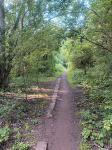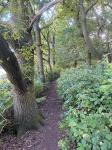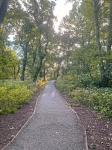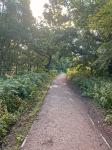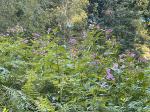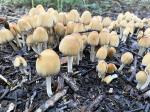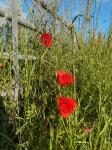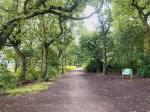Brayton Barff Through the Seasons.
Set in the Vale of York, South West of the market town of Selby and between the villages of Thorpe Willoughby and Brayton, lies Brayton Barff, a sandstone Hill approximately one hundred and fifty feet in height which was formed by glacial movement during the last Ice Age. It is a significant landmark in an otherwise flat landscape.
Today the site is primarily owned by Yorkshire Water with Selby District Council owning a small patch of the land adjacent to the A63 Selby bypass. A large underground reservoir occupies the centre of the site which delivers water to around 4.7 million customers throughout Yorkshire.
Within the Barff woodland over 40% of the trees are Sessile Oak which are generally found in semi natural woodlands in the north of the country. These trees are so called because its acorns are not held on stalks, like those of the English Oak (Pedunculate), but attached directly to the outer twigs. There are also several English Oak trees as well as some cross-hybrid oaks. These trees are known to support many species of flora and fauna, invertebrates, mosses, lichen and fungi.
During the Victorian times it is thought that the shipbuilders on the east coast would come over to the Barff for selected cuts of timber to build their sea going vessels.
The Barff also has a variety of other trees including Silver Birch, Beech, Sycamore, Holly, Rowan, Scots Pine, Alder, Hawthorne and European Larch. There are also several Yew, Willow, Hazel, Horse Chestnut and Wych Elm. As with similar woodlands there are a variety of bushes, including Honeysuckle, Elderberry, Gorse, Broom and Buddleia.
The history of Brayton Barff is quite vague, apparently during 1803 a beacon was lit on the Barff when the country was threatened with an invasion by Napoleon. In May 1935, to celebrate King George V's Silver Jubilee, a Bonfire was lit on the Barff as part of the celebrations.
Early issues of Ordnance Survey Maps dated 1903 clearly show a rifle range on the Barff, extending out to Mill Lane. During the 
Between 2001 – 2004 the A63 Selby bypass, 10km twin lane single carriageway was constructed which severed the South West corner of the Barff, adjacent to Selby Golf Course and resulted in a slight redesign of several holes on the golf course. Wooden fencing was erected as a result of this new road running alongside of the Barff and a footbridge constructed over the ‘new road’ following the line of the Bridal way which extends from Mill Lane. Around 2005/2006 a definite 2metre wide limestone aggregate footpath was laid forming a circular path around the outer edges of the woodland. This footpath is approximately 1.2 miles in length and takes about 30 minutes to circumnavigate at a leisurely pace.
In 2012 the Barff was declared an Ancient Oak Woodland and as such throughout 2012 and 2013 significant work had been carried out by the relevant agencies to cut and remove large swathes of non-native trees, creating at that time huge scars on the landscape. Some three years later the planting of the native trees have become well established and are flourishing. Ongoing maintenance work on the footpath around the bottom of the Barff was completed during the Summer of 2016.
A second phase of woodland maintenance commenced during the Autumn of 2019 with the removal of many old and diseased trees and the cutting back of the Gorse and Broom bushes, especially adjacent to the ‘bypass trail’, this work continued through till March 2020 with re planting continuing into April 2020.
Brayton Barff is a popular site for walkers and bird watchers alike and a path circling the outer perimeter of the Barff makes a pleasant thirty minute walk, giving views looking over towards Selby and the village of Brayton as well as the power stations of Drax and Eggborough..jpg)
For the early risers it is a great place to see some stunning sunrises over the villages of Brayton looking towards Drax Power Station, the same with the Sunsets looking over towards Eggborough and Monk Fryston.
The Barff changes with the Seasons and every visit can reveal something new, the woodland is a haven for wildlife. Records show that since 1982 one hundred and twelve species of bird have been seen in the woodland and at least 40 of those have bred here, including Tawny Owl, Buzzard, Green Woodpecker, Spotted Flycatcher, Goldcrest and Nuthatch to name just a few. On average over 70 species of bird are recorded each year. Further details of the bird life on the Barff can be found on the Brayton Barff Group Facebook page, especially the posts from Derek Cooper. Today ‘The Friends of Brayton Barff group’ led by Derek and a small team of volunteers help keep and maintain the cleanliness of the site as well as recording the wildlife and bird sightings.
The Barff is also home to fifteen different species of mammals, including Muntjac Deer, Pipistrelle Bat, Fox, and Field Vole.
Over eighty species of plant and wildflowers have been recorded, included Bee Orchid, Northern Marsh Orchid, Wood Anemone, Marsh Ragwort, Bluebell, White Bluebell, Bittersweet and Purple and White Foxgloves. Over twenty species of Butterfly have been recorded, including Marbled White, Brown Angus, Speckled Wood, Comma and Brimstone.
During the Autumnal months fungi thrives in this woodland environment, species including Fly Agaric, Beefsteak Tree Fungi, Chicken of the Wood, Sulphur Tufts, Stinkhorn, Ink cap, Puffballs and Hoof Bracket are just some of the many varieties that can be found here.
Click on the galleries shown below to expand the albums.
July 2020
I like this time of year on the Barff, the tree canopy is complete and the leaves have formed a thick dense blanket over the woodland floor.
Needless to say that although we are just over half way through the year, the weather for July left a lot to be desired. The first week of the month was wet and at times very wet, on two occasions I ended up putting the waterproof jackets on Meg and Gracie, much to their displeasure, but as fellow dog owners know, a wet dog stinks and mud is attracted to them like a magnet, so in order to partially protect the inside of my car as well as keeping the dogs relatively dry and clean, the jackets go but only in very wet or cold weather, Gracie being the slimmer of the two dogs is also prone to ‘cold tail’ which is brought on by wet and cold weather so at least it gives her some protection.
It is nice to walk around the Barff in the early morning light, sunrise is just after 5.00am at the moment, the dawn chorus is relatively quiet, some days are better than others for hearing it, though the birds should be coming more active now that their nesting season is coming to an end. Robins are seen around the perimeter path throughout the year and seem to follow me on my rambles around the woodland, Chiffchaff can be heard with their distinctive call as can the Wren and Dunnocks. It is always nice to see the Buzzard flying over the Barff, I am certain that it has over wintered here and possibly been breeding, though it is usually accompanied by a pair of Crows every time it takes to the wing.
The summit of the Barff is covered in Clover at the moment along with Creeping Cinquefoil and around the fringes are some huge Spear Thistles which have caught me on more than one occasion and given me quite a nasty scratch on the back of my hand as I’ve brushed past them. Unfortunately despite the best efforts of a handful of volunteers as well as contractors for the council/waterboard, the Himalayan Balsam has had another good blooming year, although a good pollinator for the Bees it is such an invasive weed and if not kept in check can soon smother other more smaller wild flowers.
With all the rain we have been having this month I was not surprised to see a lot of fungus around the woodland floor, including Stinkhorn, puff balls and Sulphur tuft.
The warm spell towards the end of the month brought out several varieties of Butterfly including Red Admiral, Large White, Meadow Brown, and Peacock to name a few, there were plenty of moths about too but at the moment I am no expert at identifying them I’m afraid.
The Barff has been relatively quiet at the moment, fortunately cases of Coronavirus seem to be dropping to a more manageable level and many of the restrictions on traveling etc are being lifted although the track and trace system is coming into operation in an effort to control and manage the virus. A one-way system is still in operation on the Barff for what it is worth, for those people who walk on the main perimeter path in order to prevent close contact.
It was nice to hear the Green Woodpecker during the latter part of the month, its distinctive yaffing call could be heard especially between the old farm shop and Tap Hill, its return to the Barff seems to be quite late this year, let’s hope it stays.
Everything is growing a pace at the moment, the Balsam stands at over 6ft in places, Brambles and nettles are thriving too, I am certain that some of the nettles are reaching heights of between 4ft – 5ft.. as well as some of the ferns, the undergrowth is becoming quite dense and impregnable.
Let’s hope that we get some dryer weather next month.
|

